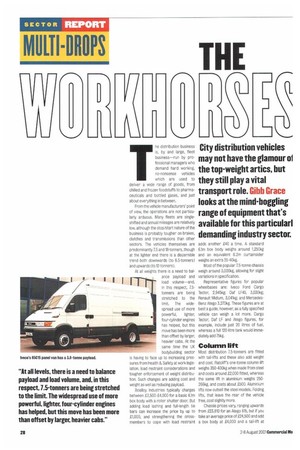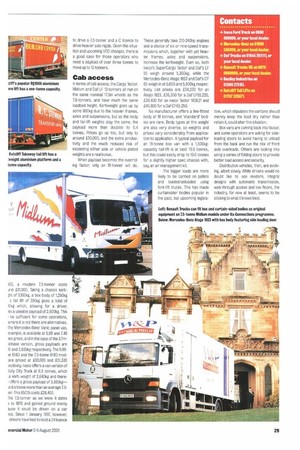T he distribution business is, by and large, fleet business—run by professional managers who demand hard working,
Page 28

Page 29

If you've noticed an error in this article please click here to report it so we can fix it.
no-nonsense vehicles which are used to deliver a wide range of goods, from chilled and frozen foodstuffs to pharmaceuticals and bottled gases, and just about everything in between.
From the vehicle manufacturers' point of view, the operations are not particularly arduous. Many fleets are singleshifted and annual mileages are relatively low, although the stop/start nature of the business is probably tougher on brakes, clutches and transmissions than other sectors. The vehicles themselves are predominantly 7.5 and 18-tonners, though at the lighter end there is a discernible trend both downwards (to 6.5-tanners) and upwards (to 12-tonners).
At all weights there is a need to balance payload and load volume—and, in this respect, 7.5tonners are being stretched to the limit. The widespread use of more powerful, lighter, four-cylinder engines has helped, but this move has been more than offset by larger, heavier cabs. At the same time the UK bodybuilding sector is having to face up to increasing pressures from Health 8, Safety at work legislation, load restraint considerations and tougher enforcement of weight distribution. Such changes are adding cost and weight as well as reducing payload.
Boalloy Industries typically charges between £3,500-£4,000 for a basic 6.1m box body with a roller shutter door. But adding load lashing and full-length tie bars can increase the price by up to £1,000, and strengthening the crossmembers to cope with load restraint adds another £40 a time. A standard 6.1m box body weighs around 1,250kg and an equivalent 6.2m curtainsider weighs an extra 35-40kg.
Most of the popular 7.5-tonne chassis weigh around 3,000kg, allowing for slight variations in specification.
Representative figures for popular wheelbases are: lveco Ford Cargo Tector, 2,945kg; Daf LF45, 3,030kg; Renault Midlum, 3,041kg: and MercedesBenz Atego 3,270kg. These figures are at best a guide, however, as a fully specified vehicle can weigh a lot more. Cargo Tector, Daf LF and Atego figures, for example, include just 20 litres of fuel, whereas a full 120-litre tank would immediately add 75kg.
Column lift
Most distribution 7.5-tanners are fitted with tail-lifts and these also add weight and cost. Ratcliff's one-tonne column lift weighs 350-400kg when made from steel and costs around £2,000 fitted, whereas the same lift in aluminium weighs 250266kg, and costs about £500. Aluminium lifts now outsell the steel models. Folding lifts, that leave the rear of the vehicle free, cost slightly more.
Chassis prices vary, ranging upwards from £23,810 for an Atego 815, but if you take an average price of £24,500 and add a box body at £4,000 and a tail-lift at
ill°, a modern 7.5-tonner costs _Ind 231,000. Taking a chassis kerb;ht of 3,100kg, a box body of 1,250kg a tail lift of 350kg gives a total of *kg wnich, allowing for a driver, es a useable payload of 2,800kg. This be sufficient for some operations, w -Jere it is not there are alternatives. fhe Mercedes-Benz Vario panel van, example, is available at 5.99 and 7.49 les gross, and in the case of the 3.7mielbase version, gross payloads are 15 and 3,935kg respectively. The 5.99le 614D and the 7.5-tonne 8140 modare priced at 230,095 and £31,330 )ectively. Ivaco offers a van version of Daily City Truck at 6.5 tomes, which a kerb weight of 2,640kg and there, offers a gross payload of 3,860kgind a tonne more than an average 7.5ter. This 65015 costs 228,450.
rho 7.5-tonner as we know it dates < to 1976 and gained ground mail* ause it could be driven on a car ice. Since 1 January 1997, however, drivers have had to hold a DI licence to drive a 7.5-tonner and a C licence to drive heaver solo rigids. Given this situation and upcoming VED changes, there is a good case for those operators who need a payload of over three tonnes to move up to 12-tanners.
Cab access
In terms of cab access, the Cargo Tector. Midlum and Oaf LF 12-tanners all run on the same nominal 17.5in wheels as the 7.5-ton ners, and have much the same loadbed height. Kerbweight goes up by some 600 kg due to the heavier frames, axles and suspensions, but as the body and tail-lift weights stay the same, the payload more than doubles to 6.4 tonnes. Prices go up too, but only to around 130,000, and the extra productivity and the much reduced risk of exceeding either axle or vehicle plated weights are a real bonus.
When payload becomes the overriding factor, only an 18-tonner will do. These generally take 210-240hp engines and a choice of six or nine-speed transmissions which, together with yet heavier frames, axles and suspensions, increase the kerbweight. Even so, both lveco's SuperCargo Tector and Daf's LF 55 weigh around 5,300kg, while the Mercedes-Benz Atego 1823 and Oaf's CF 65 weigh in at 5,600 and 5,900kg respectively. List prices are £34,230 for an Atego 1823, £36,300 for a Oaf LF55.220, £39,400 for an !yew Teeter 180E21 and £40,800 for a Oaf 0E65.250.
No manufacturer offers a line-fitted body at 18 tonnes, and 'standard' bodies are rare. Body types at this weight are also very diverse, so weights and prices vary considerably from application to application. A typical payload for an 19-tonne box van with a 1,500kgcapacity tail-lift is at best 10.5 tomes, but this could easily drop to 10.0 tonnes for a slightly higher spec chassis with, say, an air management kit.
The bigger loads are more likely to be carried on pallets and loaded/unloaded using fork-lift trucks. This has made curtainsider bodies popular in the past, but upcoming legisia tion, which stipulates the curtains should merely keep the load dry rather than retain it, could alter this situation.
Box vans are coming back into favour, and some operators are asking for sideloading doors to avoid having to unload from the back and run the risk of front axle overloads. Others are looking into using a series of folding doors to provide better load access and security.
Distribution vehicles, then, are evolving, albett slowly. While drivers would no doubt like to see modern, integral designs with automatic transmission, walk-through access and low floors, the industry, for now at least, seems to be sticking to what it knows best,




















































































































